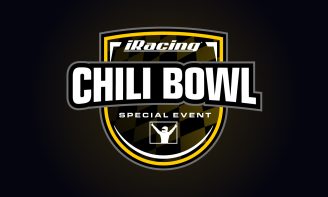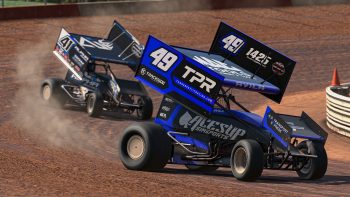
Q&A with iRacing’s Richard Jobling
May 7th, 2014 by Jaime Baker
Senior Software Engineer Richard Jobling came to iRacing from Scotland via San Francisco and Boston, MA in 2010. Having worked on the development of video games – including Grand Theft Auto – for nearly two decades, Jobling is delighted to have found a home at iRacing.com.
Q: Tell us a bit about your background and how you came to be at iRacing.
A: I’ve been working in video games since 1997. My first job was back home in Scotland with a company called DMA Design (now Rockstar) who made the Lemmings games and Grand Theft Auto; I worked on the physics and collision detection for GTA III.
Then I had an opportunity to move to California to work for one of the big Japanese companies – Namco. I did the physics, camera programming, and player controls on a game called Dead to Rights where you were an out of control cop running around shooting people. Then I worked for EA on a James Bond game, but I didn’t get to do the physics there, which is what I really liked. So I went to Visual Concepts (who make the 2K Sports games) to build a physics engine for their non-sports project. Unfortunately they later decided to focus entirely on sports and the team got dismantled, so I spent some time at Lucas Arts and then 2K Marin working on BioShock 2. By then I’d gotten married and my wife was from Boston. 2K Marin had a sister studio in Quincy, MA so we moved to Boston to work on the sequel — BioShock Infinite. I built tech for their city of floating islands.
Toward the end of that project I was looking for a change and out of the blue discovered iRacing. I e-mailed my resume to them and said “Do you need any more engineers to do physics.” Their response was ‘Why don’t you come in?” When I spoke with Steve Myers and Dave Kaemmer it seemed to be the perfect fit for what I wanted to do.
“You can concentrate on doing a good job; favor quality over quantity.”
Q: What about iRacing fits you so well?
A: There’s always room to learn and build on my experience. That opportunity has disappeared in regular video games; people just use out-of- the box software solutions to do their physics. The requirements are simpler “OK when I push this box over it looks like a box falling over” and that’s the end of it. They don’t have a use for deeper realism. But with iRacing it’s very different. There’s just no end to it: We keep going and going and going . . .
Q: How does iRacing’s “product cycle” differ from video games?
A: With regular video games, generally, you’re under a lot of pressure to fix bugs and get it out the door by a deadline. That makes it difficult to do anything technically innovative.
With four new builds a year, iRacing lets us concentrate on making improvements we want to make. If we can’t get something done for one deadline, it’s not a disaster. We just figure ‘What can we do for this deadline’ and ‘How do we get this done for the next deadline.’ You can concentrate on doing a good job; favor quality over quantity.
Q: What are some of the projects you’ve been involved with at iRacing?
A: Some behind the scenes stuff. I’ve added tools in the sim so guys working on the cars can edit properties while running to see how those changes affect the performance characteristics of the car. For example, they can see the collision shape of the car or test the car’s suspension and damping on a four post rig.
As for the things members actually see, the first thing I did was fix the way we overlay the skid marks on the road – it wasn’t conforming to the road surface very well. Now it looks a lot better.
Then I worked on the cones, a bigger project. The cones are separate physics objects and have separate collision properties, so I had to update the existing codes so the cones interact with the road and the cars and would replay properly.
When I interviewed, Dave and Steve said they really wanted to improve the damage model. There’s a lot of work to do there. To prove the concept we had to have something bouncing around that would interact with the cars and track – and the cones were the first step.
Since then I’ve been working on our collision system. The goal is to have things like wings on a car break off and get trapped under your own or somebody else’s wheels; or have the wing wobbling. You might be chasing that person and be terrified the wing will break off and ruin your race — which is a factor you have to consider in real racing.
There are benefits before that – now when you drive into the side of another car, the result (in terms of the collision damage) is not very predictable. That will be improved with the new approach.
We want crashes to look like crashes more than they do. That’s an exciting part of sim-racing, of course, but also, if you feel like the car is somewhat fragile, then you’re going to race like people really race.
Q: Who do you work with most closely at iRacing?
A: Mostly Dave and Grant (Reeve). We talk about what I could do, what I am doing and how it’s going to work. A lot of the time I’ll be working on something and Dave will give me a much deeper perspective on the physics side of it than I would have on my own. He is very adamant about things remaining physically correct and about using real world metrics to direct everything, even the cones. Grant is an auto-crosser. He’s a little bit obsessed with cones, to be honest. So he was very closely involved with the physical properties of our cones in the sim. He did not like it when they were too bouncy.
“I have a bit of a reputation for wrecking in the sim, so it makes sense that I should be working on the collision stuff.”
Q: Are you a racing fan?
A: I watch F1. I watched F1 with my dad as a kid and some of the touring car stuff. I wouldn’t same I’m a HUGE race follower but I like it. One of the reasons I came to iRacing is that I do like race cars and racing.
I had a sports car in California and I did the Jim Russell Racing experience at Sonoma. It was good fun, but I wasn’t good enough to want to pursue it further. I got scolded a couple of times in one morning because I kind of missed a corner and kept going. I don’t think anyone here would be surprised at that. I have a bit of a reputation for wrecking in the sim, so it makes sense that I should be working on the collision stuff.
Q: Final question: What’s your advice to people considering a career in video game software engineering?
Nowadays there are a lot of tools available to get you started. So in many ways it’s easier than ever to develop general skills. However it’s also more competitive than ever. I’d advise everyone to try and figure out what area they’re most interested in, be that physics, graphics or gameplay and then try to delve deeply into something specific in that area.


















































